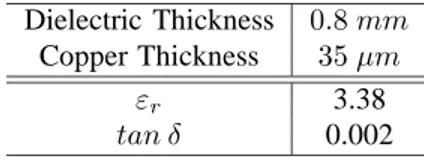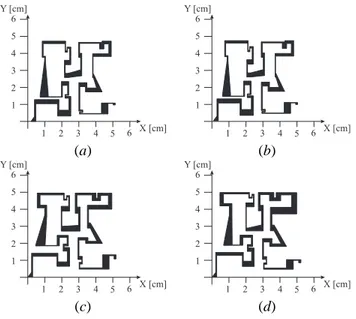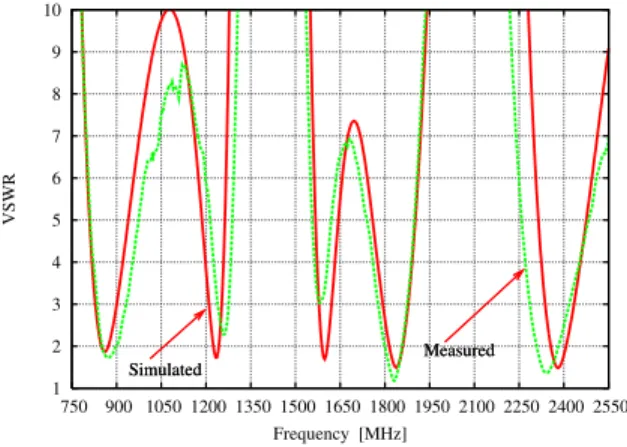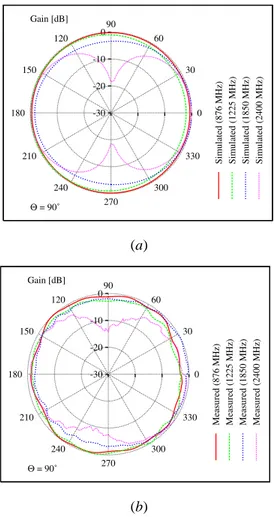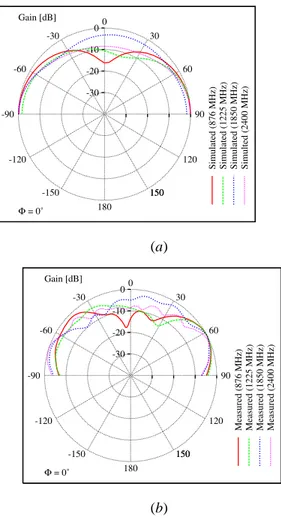UNIVERSITY
OF TRENTO
DIPARTIMENTO DI INGEGNERIA E SCIENZA DELL’INFORMAZIONE
38123 Povo – Trento (Italy), Via Sommarive 14
http://www.disi.unitn.it
A MONOPOLAR QUAD-BAND ANTENNA BASED ON A HILBERT
SELF-AFFINE PRE-FRACTAL GEOMETRY
R. Azaro, F. Viani, L. Lizzi, E. Zeni, and A. Massa
January 2011
1
A Monopolar Quad-Band Antenna based on a
Hilbert Self-Affine Pre-Fractal Geometry
Renzo Azaro, Federico Viani, Leonardo Lizzi, Edoardo Zeni, and Andrea Massa,
Abstract
In this letter, the design of a quad-band antenna is presented. The antenna has a planar geometry printed on a dielectric substrate orthogonal to a reference ground plane and its geometrical parameters are optimized starting from a Hilbert-like pre-fractal reference shape. The reliability of the synthesized antenna is assessed by means of a set of experimental tests to verify its compliance with the project constraints.
Index Terms
Multiband Antennas, Miniaturized Antennas, Pre-fractal Shape, Self-Affine Geometry, Hilbert Geometry.
I. INTRODUCTION
The space-filling properties of the Hilbert curve are very attractive for the design of fractal antennas [1]. These geometries are potential candidates to build miniaturized antennas thanks to the property of compressing long wires into small areas. Their radiation properties have been extensively analyzed in order to evaluate their effectiveness [2][3][4][5] and it has been demonstrated that usually a significant size reduction, compared to standard geometries like a λ/4 monopole, can be obtained.
However, it has been experienced that a large amount of energy is stored in the near field of the antenna and higher ohmic losses arise. The resonant frequencies of the small antennas built exploiting the Hilbert geometry [6][7][8] lower when increasing the iteration level, while keeping fixed the external dimensions of the antenna. Moreover, the radiation characteristics of the radiator worsen by decreasing the radiation resistance. Furthermore, the fundamental resonance frequency turns out to be higher than the corresponding one of a λ/4 monopole with the same physical length. Such a phenomenon is mainly due to the coupling
between the different turns of the Hilbert shape that define a shorter equivalent path for the current [9]. The effect gets stronger when the fractal iteration i increases and a saturation of the miniaturization capability verifies in correspondence with large
values ofi. In addition, the resonant efficiency decreases with increasing antenna iteration due to the increase in total metallic
path length [5]. From a practical point of view, such considerations suggest that only the first fractal iterations can be profitably employed for miniaturization purposes (e.g.,i ≤ 5 or i ≤ 6) [10]. Taking into account the properties and limitations previously
pointed out, the Hilbert curve is employed in this letter for the design of a miniaturized and multistandard monopole antenna. However, in order to fully exploit the electrodynamic properties and to minimize the negative features of Hilbert shapes, the descriptive parameters of the reference geometry are pertu rbed according to the PSO-based strategy described in [11] and here adapted to the Hilbert geometry.
The outline of the letter is as follows. Section 2 describes the reference geometry of the antenna and it gives some indications on the iterative synthesis process by showing some intermediate results as well as the final design. Section 3 is devoted to the comparative assessment between numerical results and measured values as well as to verify the fitting of the project constraints. Some conclusions are finally drawn (Sect. 4).
II. ANTENNADESIGN
The quad-band antenna is required to enable the wireless standard listed in Tab. I with a maximum V SW R value, at the
TABLE I
WIRELESSSTANDARDS
Wireless Standard Frequency Band [GHz] WSN (Europe) 0.868 - 0.870
GPS - L1 1.2245 - 1.2265
GSM 1800 1.710 - 1.990
WiFi 2.400 - 2.480
(a) (b)
Fig. 1. Pre-fractal self-similar Hilbert curve at the fractal stages: (a) i = 1 and (b) i = 2.
has been considered as reference geometry but, instead of a self-similar representation (Fig. 1 ), a self-affine [12] design has been adopted. As a matter of fact, the self-affine geometry can provide an enhanced flexibility useful for the antenna design, since resonances can be non-uniformly spaced by appropriately selecting the scale factor. In particular, additional degrees of freedom are then obtained by perturbing the Hilbert shape and varying each segment length and thickness, thus increasing the capability of the structure to fit more challenging project requirements.
By considering the Hilbert fractal shape at the stagei = 2 as reference architecture, both lengths and widths of the antenna
segments have been perturbed according to the PSO-based procedure detailed in [11]. By assuming the presence of a planar dielectric substrate whose characteristics are summarized in Tab. II , the final shape of the antenna [Fig. 2(d)] has been obtained after kconv= 350iterations. For completeness, the trial solutions defined atk = 1, k = 10, and k = 100 are displayed in Fig. 2 , as well. As it can be observed, the PSO-based strategy modifies the lengths and the widths of the segments of the reference Hilbert shape until the design in Fig. 2(d) of size 52 × 49mm2. The maximum linear dimension of the antenna (i.e., 52mm) presents a length reduction of about 39% when compared to a standard quarter-wave monopole (λW SN/4 = 86 mm) at the lowest operating wavelength.
As far as the electrical parameters are concerned, Figure 3 shows the evolution of the VSWR plot during the optimization. Starting from a detuned structure (k = 1), the PSO strategy is able to find more satisfactory solutions (e.g., k = 10 and k = 100) until the final antenna (k = kconv) that complies the project guidelines in terms of matching conditions.
III. ANTENNA TESTING
According to the specifications from the numerical synthesis, a prototype of the antenna (Fig. 4 ) has been built by printing
The authors are with the Department of Information Engineering and Computer Science, University of Trento, Via Sommarive 14, 38050 Trento - Italy (e-mail: renzo.azaro, federico.viani, leonardo.lizzi, [email protected]; [email protected])
TABLE II
GEOMETRICAL AND DIELECTRIC PARAMETERS OF THE ANTENNA STRUCTURE
Dielectric Thickness 0.8 mm
Copper Thickness 35µm
εr 3.38
3 2 1 3 1 2 3 4 X [cm] Y [cm] 5 6 4 5 6 1 2 3 1 2 3 4 X [cm] Y [cm] 5 6 4 5 6 (a) (b) 2 1 3 1 2 3 4 X [cm] Y [cm] 5 6 4 5 6 1 2 3 1 2 3 4 X [cm] Y [cm] 5 6 4 5 6 (c) (d)
Fig. 2. Quad-band Hilbert antenna - Iterative Synthesis Process. Antenna geometry at (a) k = 1, (b) k = 10, (c) k = 100, and (d) k = kconv.
103 102 101 100 750 900 1050 1200 1350 1500 1650 1800 1950 2100 2250 2400 2550 VSWR Frequency [MHz] k = 1 k = 10 k = 100 k = 200 kconv Measured
Fig. 3. Quad-band Hilbert antenna - Iterative Synthesis Process. Evolution of the VSWR values.
1 2 3 4 5 6 7 8 9 10 750 900 1050 1200 1350 1500 1650 1800 1950 2100 2250 2400 2550 VSWR Frequency [MHz] Simulated Measured Simulated Measured
Fig. 5. Measured and simulated VSWR values of the quad-band Hilbert antenna.
the Hilbert-like shape on an Arlon dielectric substrate (Tab. II). Concerning the experimental validation of the numerical modelling, both VSWR and gain measurements of the antenna prototype have been performed in an anechoic chamber. Figure 5 shows the plots of both simulated and measured VSWR values. As it can be noticed, there is a satisfactory agreement between simulations and measurements. The differences, more evident in theGP S and W iF i bands, are mainly due to: a) the
differences between actual and theoretical values (i.e., those assumed during the synthesis process) of the dielectric properties; b) the variations of the real value of the dielectric permittivity in the frequency spectrum while constant values forεrandtanδ have been considered in the simulations; c) the finite dimension of the reference ground plane used during the experimental tests (while an infinite ground plane has been considered in the numerical simulations).
As regards to the radiation properties of the prototype, Figure 6 and Figure 7 show the normalized values of the simulated and measured patterns along the horizontal and the vertical plane, respectively. As requested, the antenna prototype behaves as a monopole and it turns out to be suitable to enable the wireless communications in the project bands.
IV. CONCLUSIONS
In this letter, a monopolar quad-band antenna based on a Hilbert self-affine pre-fractal geometry has been described. An antenna prototype has been built by printing the synthesized shape on a planar dielectric substrate equipped with a reference ground plane. The antenna performances have been positively assessed by means of some experiments devoted to verify the compliance of both the VSWR behavior and the radiation properties with the project constraints.
REFERENCES
[1] D. H. Werner and S. Ganguly, "An overview of fractal antenna engineering research," IEEE Antennas Propag. Magazine, vol. 45, no. 1, pp. 39-57, Feb. 2003.
[2] K. J. Vinoy, K. A. Jose, V. K. Varadan, and V. V. Varadan, “Hilbert curve fractal antenna: a small resonant antenna for VHF/UHF applications,”
Microwave Opt. Tech. Lett., vol. 29, no. 4, pp. 215-219, May 2001.
[3] S. R. Best and J. D. Morrow, "The effectiveness of space-filling fractal geometry in lowering resonant frequency," IEEE Antennas Wireless Propagat.
Lett., vol. 1, pp. 112-115, 2002.
[4] J. M. Gonzales-Arbesù, S. Blanch, and J. Romeu, "Are space-filling curves efficient small antennas?," IEEE Antennas Wireless Propagat. Lett., vol. 2, pp. 147-150, 2003.
[5] S. R. Best, "A comparison of the resonant properties of small space-filling fractal antennas," IEEE Antennas Wireless Propagat. Lett., vol. 2, pp. 197-200, 2003.
[6] J. Anguera, C. Puente, E. Martinez, and E. Rozan, “The fractal Hilbert monopole: a two dimensional wire,” Microwave Opt. Tech. Lett., vol. 36, no. 2, pp. 102-104, Jan. 2003.
[7] S. R. Best, “A comparison of the performance properties of the Hilbert curve fractal and meander line monopole antennas,” Microwave Opt. Tech. Lett., vol. 35, no. 4, pp. 258-262, Nov. 2002.
[8] J. M. Gonzales-Arbesù, S. Blanch, and J. Romeu, “The Hilbert curve as a small self-resonant monopole from a practical point of view,” Microwave Opt.
Tech. Lett., vol. 39, no. 1, pp. 45-49, Oct. 2003.
[9] M. Barra, C. Collado, J. Mateu, and J. M. O’Callaghan, “Miniaturization of superconductive filters using Hilbert fractal curves,” IEEE Applied
5 0 -10 -20 -30 Gain [dB] Θ = 90˚ 0 30 60 90 120 150 180 210 240 270 300
330 Simulated (876 MHz) Simulated (1225 MHz) Simulated (1850 MHz) Simulated (2400 MHz)
(a) 0 -10 -20 -30 Gain [dB] Θ = 90˚ 0 30 60 90 120 150 180 210 240 270 300
330 Measured (876 MHz) Measured (1225 MHz) Measured (1850 MHz) Measured (2400 MHz)
(b)
Fig. 6. Horizontal radiation pattern: Normalized (a) simulated and (b) measured values.
[10] M. Barra, C. Collado, J. Mateu, and J. M. O’Callaghan, “Hilbert fractal curves for HTS miniaturized filters,” in Microwave Symp. Dig., 2004 IEEE
MTT-S Int., pp.123-126.
[11] R. Azaro, F. De Natale, M. Donelli, E. Zeni, and A. Massa, “Synthesis of a prefractal dual-band monopolar antenna for GPS applications,” IEEE
Antennas Wireless Propag. Lett., vol. 5, pp. 361-364, 2006.
0 -10 -20 -30 Gain [dB] Φ = 0˚ 180 150 150 120 90 60 30 0 -30 -60 -90 -120 -150
Simulated (876 MHz) Simulated (1225 MHz) Simulated (1850 MHz) Simulted (2400 MHz)
(a) 0 -10 -20 -30 Gain [dB] Φ = 0˚ 180 150 150 120 90 60 30 0 -30 -60 -90 -120 -150
Measured (876 MHz) Measured (1225 MHz) Measured (1850 MHz) Measured (2400 MHz)
(b)
